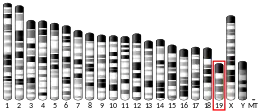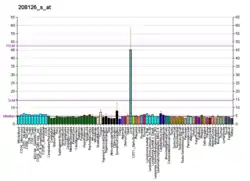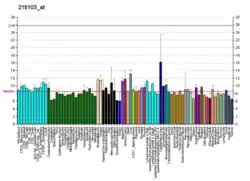CYP2C18
Cytochrome P450 2C18 is a protein that in humans is encoded by the CYP2C18 gene.[5][6][7]
Function
This gene encodes a member of the cytochrome P450 superfamily of enzymes. The cytochrome P450 proteins are monooxygenases which catalyze many reactions involved in drug metabolism and synthesis of cholesterol, steroids and other lipids. This protein localizes to the endoplasmic reticulum but its specific substrate has not yet been determined. The gene is located within a cluster of cytochrome P450 genes on chromosome 10q24. An additional gene, CYP2C17, was once thought to exist; however, CYP4217 is now considered an artefact based on a chimera of CYP2C18 and CYP2C19.[7]
CYP2C18 also possesses epoxygenase activity: it can attack various long-chain polyunsaturated fatty acids at their double (i.e. alkene) bonds to form epoxide products that act as signaling agents. It metabolizes: 1) arachidonic acid to various epoxyeicosatrienoic acids (also termed EETs); 2) linoleic acid to 9,10-epoxy octadecaenoic acids (also termed vernolic acid, linoleic acid 9:10-oxide, or leukotoxin) and 12,13-epoxy-octadecaenoic (also termed coronaric acid, linoleic acid 12,13-oxide, or isoleukotoxin); 3) docosahexaenoic acid to various epoxydocosapentaenoic acids (also termed EDPs); and 4) eicosapentaenoic acid to various epoxyeicosatetraenoic acids (also termed EEQs).[8][9][10]
While CYP2C19, CYP2C8, CYP2C9, CYP2J2, and possibly CYP2S1 are the main producers of EETs and, very likely EEQs, EDPs, and the epoxides of linoleic acid, CYP2C18 may contribute to the production of these metabolites in certain tissues.[9][11]
References
- GRCh38: Ensembl release 89: ENSG00000108242 - Ensembl, May 2017
- GRCm38: Ensembl release 89: ENSMUSG00000025002 - Ensembl, May 2017
- "Human PubMed Reference:". National Center for Biotechnology Information, U.S. National Library of Medicine.
- "Mouse PubMed Reference:". National Center for Biotechnology Information, U.S. National Library of Medicine.
- Furuya H, Meyer UA, Gelboin HV, Gonzalez FJ (September 1991). "Polymerase chain reaction-directed identification, cloning, and quantification of human CYP2C18 mRNA". Molecular Pharmacology. 40 (3): 375–82. PMID 1896026.
- Romkes M, Faletto MB, Blaisdell JA, Raucy JL, Goldstein JA (April 1991). "Cloning and expression of complementary DNAs for multiple members of the human cytochrome P450IIC subfamily". Biochemistry. 30 (13): 3247–55. doi:10.1021/bi00227a012. PMID 2009263.
- "Entrez Gene: CYP2C18 cytochrome P450, family 2, subfamily C, polypeptide 18".
- Fleming I (October 2014). "The pharmacology of the cytochrome P450 epoxygenase/soluble epoxide hydrolase axis in the vasculature and cardiovascular disease". Pharmacological Reviews. 66 (4): 1106–40. doi:10.1124/pr.113.007781. PMID 25244930.
- Wagner K, Vito S, Inceoglu B, Hammock BD (October 2014). "The role of long chain fatty acids and their epoxide metabolites in nociceptive signaling". Prostaglandins & Other Lipid Mediators. 113–115: 2–12. doi:10.1016/j.prostaglandins.2014.09.001. PMC 4254344. PMID 25240260.
- Fischer R, Konkel A, Mehling H, Blossey K, Gapelyuk A, Wessel N, von Schacky C, Dechend R, Muller DN, Rothe M, Luft FC, Weylandt K, Schunck WH (March 2014). "Dietary omega-3 fatty acids modulate the eicosanoid profile in man primarily via the CYP-epoxygenase pathway". Journal of Lipid Research. 55 (6): 1150–1164. doi:10.1194/jlr.M047357. PMC 4031946. PMID 24634501.
- Spector AA, Kim HY (April 2015). "Cytochrome P450 epoxygenase pathway of polyunsaturated fatty acid metabolism". Biochimica et Biophysica Acta (BBA) - Molecular and Cell Biology of Lipids. 1851 (4): 356–65. doi:10.1016/j.bbalip.2014.07.020. PMC 4314516. PMID 25093613.
External links
- Human CYP2C18 genome location and CYP2C18 gene details page in the UCSC Genome Browser.
Further reading
- Goldstein JA, de Morais SM (December 1994). "Biochemistry and molecular biology of the human CYP2C subfamily". Pharmacogenetics. 4 (6): 285–99. doi:10.1097/00008571-199412000-00001. PMID 7704034.
- Smith G, Stubbins MJ, Harries LW, Wolf CR (December 1998). "Molecular genetics of the human cytochrome P450 monooxygenase superfamily". Xenobiotica. 28 (12): 1129–65. doi:10.1080/004982598238868. PMID 9890157.
- Ged C, Beaune P (June 1992). "Partial sequence and polymerase chain reaction-mediated analysis of expression of the human CYP2C18 gene". Pharmacogenetics. 2 (3): 109–15. doi:10.1097/00008571-199206000-00002. PMID 1306110.
- Romkes M, Faletto MB, Blaisdell JA, Raucy JL, Goldstein JA (February 1993). "Cloning and expression of complementary DNAs for multiple members of the human cytochrome PH50IIC subfamily". Biochemistry. 32 (5): 1390. doi:10.1021/bi00056a025. PMID 8095407.
- Goldstein JA, Faletto MB, Romkes-Sparks M, Sullivan T, Kitareewan S, Raucy JL, Lasker JM, Ghanayem BI (February 1994). "Evidence that CYP2C19 is the major (S)-mephenytoin 4'-hydroxylase in humans". Biochemistry. 33 (7): 1743–52. doi:10.1021/bi00173a017. PMID 8110777.
- Maruyama K, Sugano S (January 1994). "Oligo-capping: a simple method to replace the cap structure of eukaryotic mRNAs with oligoribonucleotides". Gene. 138 (1–2): 171–4. doi:10.1016/0378-1119(94)90802-8. PMID 8125298.
- de Morais SM, Schweikl H, Blaisdell J, Goldstein JA (July 1993). "Gene structure and upstream regulatory regions of human CYP2C9 and CYP2C18". Biochemical and Biophysical Research Communications. 194 (1): 194–201. doi:10.1006/bbrc.1993.1803. PMID 8333835.
- Richardson TH, Griffin KJ, Jung F, Raucy JL, Johnson EF (February 1997). "Targeted antipeptide antibodies to cytochrome P450 2C18 based on epitope mapping of an inhibitory monoclonal antibody to P450 2C51". Archives of Biochemistry and Biophysics. 338 (2): 157–64. doi:10.1006/abbi.1996.9817. PMID 9028867.
- Zaphiropoulos PG (June 1997). "Exon skipping and circular RNA formation in transcripts of the human cytochrome P-450 2C18 gene in epidermis and of the rat androgen binding protein gene in testis". Molecular and Cellular Biology. 17 (6): 2985–93. doi:10.1128/mcb.17.6.2985. PMC 232150. PMID 9154796.
- Suzuki Y, Yoshitomo-Nakagawa K, Maruyama K, Suyama A, Sugano S (October 1997). "Construction and characterization of a full length-enriched and a 5'-end-enriched cDNA library". Gene. 200 (1–2): 149–56. doi:10.1016/S0378-1119(97)00411-3. PMID 9373149.
- Macé K, Bowman ED, Vautravers P, Shields PG, Harris CC, Pfeifer AM (May 1998). "Characterisation of xenobiotic-metabolising enzyme expression in human bronchial mucosa and peripheral lung tissues". European Journal of Cancer. 34 (6): 914–20. doi:10.1016/S0959-8049(98)00034-3. PMID 9797707.
- Klose TS, Blaisdell JA, Goldstein JA (1999). "Gene structure of CYP2C8 and extrahepatic distribution of the human CYP2Cs". Journal of Biochemical and Molecular Toxicology. 13 (6): 289–95. doi:10.1002/(SICI)1099-0461(1999)13:6<289::AID-JBT1>3.0.CO;2-N. PMID 10487415.
- Finta C, Zaphiropoulos PG (February 2000). "The human CYP2C locus: a prototype for intergenic and exon repetition splicing events". Genomics. 63 (3): 433–8. doi:10.1006/geno.1999.6063. PMID 10704292.
- Thum T, Borlak J (March 2000). "Gene expression in distinct regions of the heart". Lancet. 355 (9208): 979–83. doi:10.1016/S0140-6736(00)99016-0. PMID 10768437. S2CID 23176414.
- Marill J, Cresteil T, Lanotte M, Chabot GG (December 2000). "Identification of human cytochrome P450s involved in the formation of all-trans-retinoic acid principal metabolites". Molecular Pharmacology. 58 (6): 1341–8. doi:10.1124/mol.58.6.1341. PMID 11093772.
- Zhu-Ge J, Yu YN, Qian YL, Li X (October 2002). "Establishment of a transgenic cell line stably expressing human cytochrome P450 2C18 and identification of a CYP2C18 clone with exon 5 missing". World Journal of Gastroenterology. 8 (5): 888–92. doi:10.3748/wjg.v8.i5.888. PMC 4656581. PMID 12378636.






